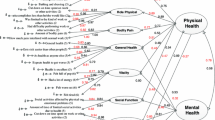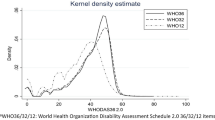Abstract
Background and objective
Individuals experiencing a change in health may experience a response shift that may attenuate HRQoL change estimates. The objective of this study was to estimate the proportion of individuals with multiple sclerosis (MS) who experienced a response shift as detected by the Latent Trajectory of Residuals approach.
Methods
Participants in the NARCOMS Registry were included if they responded to the general health (GH) question of the SF-12 in at least 3 surveys. Linear growth modeling was used to identify predictors of self-reported GH, and the residuals from this model were used to determine group-based trajectories. Dual trajectories of GH and a measure of disability (PDSS) were used to examine convergence in change patterns over time.
Results
A total of 1,566 individuals were included in this study. The predictive GH model explained 55% of the variance; 99.7% of subjects did not experience a response shift as indicated by flat trajectories, and 0.3% lowered their rating of health as compared to predicted indicating a potential response shift. Among 13% of subjects with flat trajectories of PDDS, 5% had GH decreasing most strongly showing some discordance between symptoms and GH.
Conclusions
A lower percentage of individuals experienced response shift than previous research on smaller samples. These results may indicate the true absence of response shift, or may be limited by using a categorical outcome of GH, and GH predictors that may have also been amenable to response shift, which decreases the appropriateness of using the LTA approach. Future work will include the use of growth curve latent class analyses to assess response shift.


Similar content being viewed by others
References
Schwartz, C. E., & Sprangers, M. A. (1999). Methodological approaches for assessing response shift in longitudinal health-related quality-of-life research. Social Science and Medicine, 48, 1531–1548.
Sprangers, M. A., & Schwartz, C. E. (1999). Integrating response shift into health-related quality of life research: A theoretical model. Social Science and Medicine, 48, 1507–1515.
Ahmed, S., Mayo, N. E., Wood-Dauphinee, S., Hanley, J. A., & Cohen, R. (2005). The structural equation modeling technique did not show a response shift, contrary to the results of the then test and the individualized approaches. Journal of Clinical Epidemiology, 58, 1125–1133.
Barclay-Goddard, R., Epstein, J. D., & Mayo, N. E. (2009). Response shift: A brief overview and proposed research priorities. Quality of Life Research, 18, 335–346.
Mayo, N. E., Scott, S. C., Dendukuri, N., Ahmed, S., & Wood-Dauphinee, S. (2008). Identifying response shift statistically at the individual level. Quality of Life Research, 17, 627–639.
Buchanan, T., & Smith, J. L. (1999). Using the Internet for psychological research: Personality testing on the World Wide Web. British Journal of Psychology, 90(Pt 1), 125–144.
Ryan, J. M., Corry, J. R., Attewell, R., & Smithson, M. J. (2002). A comparison of an electronic version of the SF-36 General Health Questionnaire to the standard paper version. Quality of Life Research, 11, 19–26.
Hardré, P. L., Crowson, H. M., Kui, X., & Cong, L. (2007). Testing differential effects of computer-based, web-based and paper-based administration of questionnaire research instruments. British Journal of Educational Technology, 38, 5–22.
Ware, J. E. Jr., Kosinski, M., & Keller, S. D. (1995). SF-12: How to score the SF-12 physical and mental health summary scales (2nd ed.). Boston MA: The Health Institute, New England Medical Center.
Ware, J. E., Jr., Kosinski, M., & Keller, S. D. (1996). A 12-item short-form health survey. Construction of scales and preliminary tests of reliability and validity. Medical and Care, 34, 220–233.
Schwartz, C. E., Vollmer, T., & Lee, H. (1999). Reliability and validity of two self-report measures of impairment and disability for MS. North American Research Consortium on Multiple Sclerosis Outcomes Study Group. Neurology, 52, 63–70.
Hohol, M. J., Orav, E. J., & Weiner, H. L. (1995). Disease steps in multiple sclerosis: A simple approach to evaluate disease progression. Neurology, 45, 251–255.
Kurtzke, J. F. (1983). Rating neurologic impairment in multiple sclerosis: an expanded disability status scale (EDSS). Neurology, 33, 1444–1452.
Singer, J. D., & Willett, J. B. (2003). Applied longitudinal data analysis: Modeling change and event occurrence. Oxford, New York: Oxford University Press.
Nagin, D. S., & Tremblay, R. E. (2001). Analyzing developmental trajectories of distinct but related behaviors: A group-based method. Psychology Methods, 6, 18–34.
Jones, B. L., Nagin, D. S., & Roeder, K. A. T. H. (2001). A SAS procedure based on mixture models for estimating developmental trajectories. Sociological Methods & Research, 29, 374–393.
Akaike, H. (1974). A new look at the statistical model identification. IEEE Transactions on Automatic Control, 19, 716–723.
Konishi, S., & Kitagawa, G. (1996). Generalised information criteria in model selection. Biometrika, 83, 875–890.
Nagin, D. S., & Odgers, C. L. (2010). Group-based trajectory modeling in clinical research. Annual Review of Clinical Psychology, 6, 109–138.
Schwartz, C. E., Bode, R., Repucci, N., Becker, J., Sprangers, M. A., et al. (2006). The clinical significance of adaptation to changing health: A meta-analysis of response shift. Quality of Life Research, 15, 1533–1550.
Jung, T., & Wickrama, K. A. S. (2008). An introduction to latent class growth analysis and growth mixture modeling. Social and Personality Psychology Compass, 2, 302–317.
Acknowledgments
This work is supported in part by the Fonds de la Recherche en Santé du Québec to Dr. Ahmed, and by a Visiting Scientist Fellowship from the Consortium of Multiple Sclerosis Centers to Dr. Schwartz.
Author information
Authors and Affiliations
Corresponding author
Additional information
An erratum to this article can be found at http://dx.doi.org/10.1007/s11136-011-0093-3
Rights and permissions
About this article
Cite this article
Ahmed, S., Mayo, N., Scott, S. et al. Using latent trajectory analysis of residuals to detect response shift in general health among patients with multiple sclerosis article. Qual Life Res 20, 1555–1560 (2011). https://doi.org/10.1007/s11136-011-0005-6
Accepted:
Published:
Issue Date:
DOI: https://doi.org/10.1007/s11136-011-0005-6




